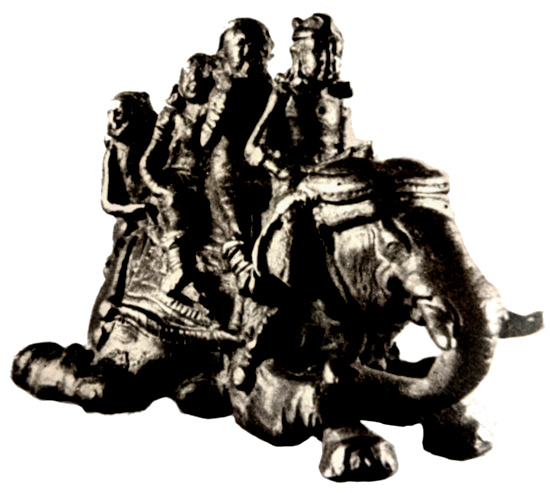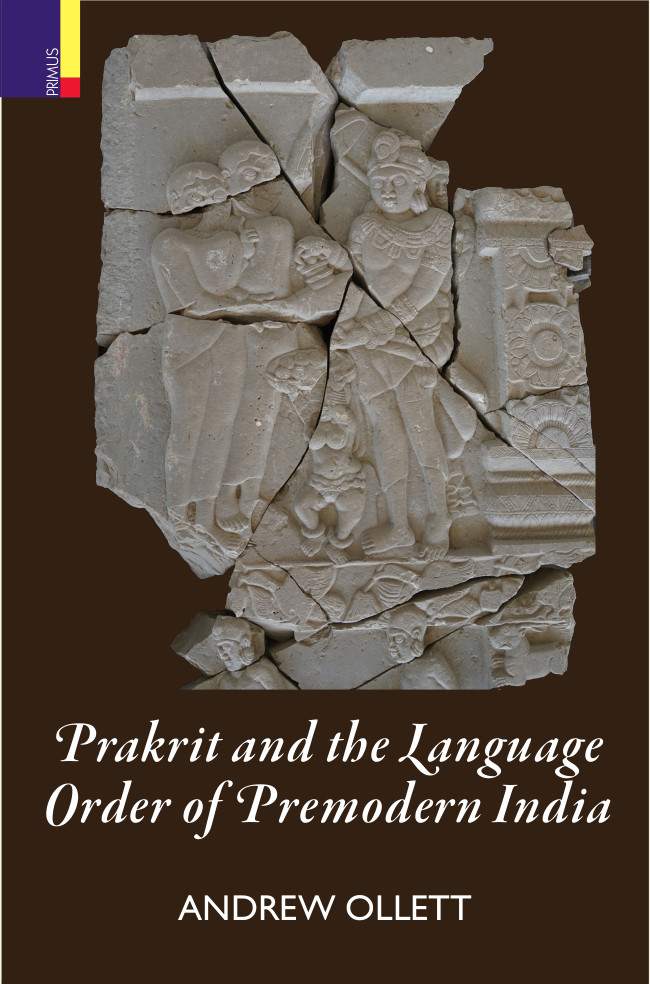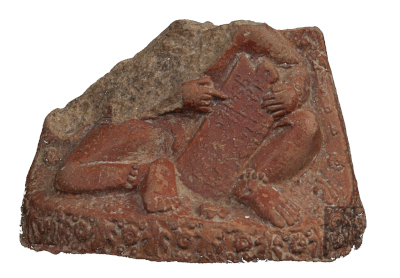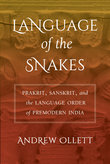
I am an Assistant Professor in the Department of South Asian Languages and Civilizations at the University of Chicago. I work on the literary and intellectual traditions of South and Southeast Asia, including:
- the philosophy of language in India, especially questions of sentence meaning and contextual meaning;
- poetics, especially including works in Prakrit and Kannada;
- the transition to manuscript literacy in South Asia;
- issues of language choice, literary multilingualism, and vernacularity;
- Prakrit literature and literary history.

I am the co-founder and editor of NESAR (New Explorations in South Asia Research), an open-access journal of South Asian Studies.
My profile on panditproject.org (a prosopographical database for South Asian intellectuals and their works) and GitHub.
I no longer update my academia.edu profile, since it is a for-profit company loaded with advertisements.
Books
Lilavai by Kouhala
Murty Classical Library of India, Harvard University Press, Cambridge, Mass., 2021.
The Prakrit romance Lilavai, an early ninth-century poem attributed to Kouhala and set in modern-day coastal Andhra Pradesh, is the most celebrated work in the genre. Complexly narrated in the alternating voices of its heroines and heroes and featuring a cast of semi-divine and magical beings, it centers on three young women: Lilavai, princess of Sinhala (today’s Sri Lanka); her cousin Mahanumai, princess of the mythical city Alaka; and Kuvalaavali, Mahanumai’s adopted sister. Following a prophecy that Lilavai’s husband will rule the earth, the princess happens upon a portrait of King Hala of Pratishthana and immediately falls in love. While journeying to meet him, she hears her cousins’ tales of their lost loves, and then vows not to marry until they are reunited. To win Lilavai’s hand, King Hala journeys to the underworld, faces monsters, and overcomes armies.
Lilavai explores themes of karma and female desire, notably privileging women as storytellers. A new edition of the Prakrit text, presented in the Devanagari script, accompanies a new English prose translation.

Language of the Snakes: Prakrit, Sanskrit, and the Language Order of Premodern India
University of California Press, Oakland, 2017.
This book is open access and published under a Creative Commons license. You can download it.
Prakrit, Sanskrit, and the Language Order of Premodern India
South Asian edition. Published by Primus Books, New Delhi, 2018.
- Interview about Language of the Snakes with Malcolm Keating on the New Books Network podcast.
- Review by Lidia Wojtczak in Cracow Indological Studies 20.2 (2017): 117–124.
10.12797/CIS.19.2017.02.06 | pdf
- Review by Nalini Balbir in Bulletin de l’école française d’extrême-orient 106 (2020): 516–519. | pdf
Language of the Snakes traces the history of the Prakrit language as a literary phenomenon, starting from its cultivation in courts of the Deccan in the first centuries of the common era. Although little studied today, Prakrit was an important vector of the kavya movement and once joined Sanskrit at the apex of classical Indian literary culture. The opposition between Prakrit and Sanskrit was at the center of an enduring “language order” in India, a set of ways of thinking about, naming, classifying, representing, and ultimately using languages. As a language of classical literature that nevertheless retained its associations with more demotic language practices, Prakrit both embodies major cultural tensions—between high and low, transregional and regional, cosmopolitan and vernacular—and provides a unique perspective onto the history of literature and culture in South Asia.
Articles
“‘A Mirror and a Handlamp’: The Way of the Poet-King and the Afterlife of the Mirror in the World of Kannada Literature.” (a chapter, edited by myself, with contributions by Sarah Pierce Taylor, Gil Ben-Herut, and myself) In Yigal Bronner (ed.), A Lasting Vision, Oxford University Press, 92–140.
10.1093/oso/9780197642924.003.0003.
“Poetics Before Dandin” (with Yigal Bronner). Section 5.2 in Yigal Bronner (ed.), A Lasting Vision, Oxford University Press, 255–258.
10.1093/oso/9780197642924.003.0006.
“‘This Globe Where Man Is Nothing’” (part of a symposium in response to Dipesh Chakrabarty’s The Climate of History in a Planetary Age). Review of Politics 84.4 (2022): 593–597.
10.1017/S0034670522000687. | pdf BibTex
- “The Application of Mīmāṁsā Interpretive Concepts on Commentaries in Plays.” Forthcoming in Asiatische Studien / Études asiatiques.
- “Plumbing the depths: reading Bhavabhūti in seventeenth-century Kerala” (with Anand Venkatkrishnan). Asiatische Studien / Études asiatiques 2022.
10.1515/asia-2021-0036. | pdf BibTex
- “Buddhism in Konkan and the Western Deccan” (with Pia Brancaccio). Forthcoming in the Brill Encyclopedia of Buddhism, volume IV.
- “Non-canonical subjects in the Prakrit of Kōūhala’s Līlāvaī.” Journal of the American Oriental Society 142.2 (2022): 273–292. | pdf BibTex
- “Attempted Iconoclasm: Mahmud of Ghazna, King Yoga, and the Poet Dhanapāla.” Comparative Studies of South Asia, Africa, and the Middle East 42.2 (2022): 309–324.
10.1215/1089201X-9987762. | pdf BibTex
- “Against Vēdānta: Śālikanātha on the Upaniṣads.” Forthcoming in a collection of essays on Maṇḍana edited by E. Freschi.
- “Two Stories about the Transmission of Knowledge.” In Coming to Know, volume 2 of the series An Archaeology of Listening, edited by Nida Ghouse and Brooke Holmes. Truccazano, Milan, Italy: Archive Books, 2022, 92-104, 119-120. | pdf
- “Images of Language Mixture in Early Kannada Literature.” In Chenna Reddy (ed.), Nagabharanam (a festschrift for Hampa Nagarajaiah). 2022. | pdf (Note: I never received proofs of this article. It has been published, but I haven’t seen it yet!)
- “Taking the Measure of A Hundred Measures.” In Yigal Bronner and Charles Hallisey (eds.), Sensitive Reading: The Pleasures of South Asian Literature in Translation, pp. 229–233. Oakland: University of California Press.
https://doi.org/10.1525/luminos.114.o. | BibTex
- “Kumārila Bhaṭṭa’s Explanation in Verse,” “Prabhākara’s Long Explanation,” and “Śālikanātha’s Straightforward and Lucid Gloss; Comprehensive Survey of the Epistemic Instruments” (all with Elisa Freschi). Chapters 1, 2 and 3 in Malcolm Keating (ed.), Controversial Reasoning in Indian Philosophy: Major Texts and Arguments on Arthâpatti, pp. 43–110. London: Bloomsbury Academic. | pdf
- “Śālikanātha’s ‘Introduction’ to His ‘Fundamentals of Sentence Meaning.’” In Alessandro Graheli (ed.), The Bloomsbury Research Handbook of Indian Philosophy of Language, pp. 251–277. London: Bloomsbury Academic. | pdf
- “Rasa as Sentence Meaning.” In Alessandro Graheli (ed.), The Bloomsbury Research Handbook of Indian Philosophy of Language, pp. 371–395. London: Bloomsbury Academic. | pdf
- “The Prakrit Mirror of Ornaments and Bhāmaha’s Ornament of Literature.” In Jayandra Soni and Hampa Nagarajaiah (eds.), Cāruśrī: Essays in Honor of Bhaṭṭāraka Cārukīrti, 163–174. Bangalore: Sapna Book House, 2019. | pdf
- “Duty and Sacrifice: A Logical Analysis of the Mīmāṃsā Theory of Vedic Injunctions.” (with Elisa Freschi and Matteo Pascucci). History and Philosophy of Logic 40 (2019): 323-354.
10.1080/01445340.2019.1615366. | pdf
- “Making it Nice: Kāvya in the Second Century.” Journal of Indian Philosophy 47 (2019): 269–287.
10.1007/s10781-018-09378-7. | pdf
- “Sātavāhana and Nāgārjuna: Religion and the Sātavāhana State.” Journal of the International Association of Buddhist Studies 41 (2018): 421–472.
10.2143/JIABS.41.0.3285748. | pdf
- “Explaining Prakrit Poetry in the 18th Century: Vrajarāja Dīkṣita’s Commentary on Hāla’s Seven Centuries.” Bulletin de l’école française d’extrême-orient 103 (2018): 11–41. | pdf
- “Pālitta and the History of Prakrit Literature.” In Peter Flügel and Nalini Balbir (eds.), Jain Studies: Select Papers at Bangkok and Kyoto. Delhi: DK Publishers Distributors, 2018. | pdf
- “High-Density Expressions in The Way of the Poet-King.” Rivista degli Studi Orientali N.S. 90 (2017): 93–105.
10.19272/201703804006. | pdf
- “Ghosts from the Past: India’s Undead Languages.” Indian Social and Economic History Review 51.4 (2014): 405–466.
10.1177/0019464614550761. | pdf
- “Ritual Texts and Literary Texts in Abhinavagupta’s Aesthetics: Notes on the Beginning of the ‘Critical Reconstruction.’” Journal of Indian Philosophy 2015.
10.1007/s10781-015-9277-4. | pdf
“Thieves in the Storehouse of Sarasvatī: Metaliterary Aspects of the Caurapañcāśikā.” Asian Literature and Translation 2.4 (2014): 1–15. | pdf
- “Evidence of Laryngeal Coloring in Proto-Indo-Iranian.” Historische Sprachforschung 127 (2014, appeared 2016): 150–165. | pdf
- “The gaṇacchandas in Indian metrical theory.” In Nina Mirnig, Peter Szanto, and Michael Williams (eds.), Puṣpikā: Tracing Ancient India through Texts and Traditions (Contributions to Current Research in Indology), pp. 331–363. Oxbow: Oxford, 2013. | pdf
- “What is Bhāvanā?” Journal of Indian Philosophy 41.3 (2013): 221–262.
10.1007/s10781-013-9181-8. | pdf
- “Moraic Feet in Prakrit Metrics: A Constraint-Based Approach.” Transactions of the Philological Society 110.2 (2012): 241–282.
10.1111/j.1467-968X.2012.01307.x. | pdf
- “Memorandum of Receipt of Grain by a mesites.” Zeitschrift für Papyrologie und Epigraphik 177 (2011): 234–236. | pdf
Reviews
- of Johannes Bronkhorst, A Śabda Reader: Language in Classical Indian Thought (New York: Columbia University Press, 2019). In Philosophy East and West 71.2 (2021): 1–5.
10.1353/pew.2021.0036. | pdf
- of Cynthia Talbot, The Last Hindu Emperor: Prithviraj Chauhan and the Indian Past 1200–2000 (Cambridge: Cambridge University Press, 2016). In Bulletin of the School of Oriental and African Studies 80.2 (2017): 388–389. | pdf
- of Elisa Freschi, Duty, Language and Exegesis in Prābhākara Mīmāṃsā: Including an Edition and Translation of Rāmānujācārya’s Tantrarahasya, Śāstraprameyapariccheda (Leiden: Brill, 2012). In Philosophy East and West 65.2 (2015): 632–636. | pdf
Talks
- Indumatī’s Silence. ACSA, Madison, October 2022.
- On campū-. ACSA, Madison, October 2022.
- The body of knowledge. Jaina Studies Workshop, SOAS, June 2022.
- Is there a Buddhist theory of sentence-meaning? Buddhist philosophy workshop, Harvard, May 2022.
- Known unknowns. Franke Center for the Humanities, May 2022.
- The return of the repressed. Madison South Asia Conference, October 2021.
- Open-source philology. Princeton, February 2021.
- The context principle in Indian philosophy of language. Yale, March 2020.
- Rasa as sentence meaning. Madison South Asia Conference, 2018.
- Pālitta’s Taraṅgavatī. University of Mysore, Sept. 2018.
- How to read Hāla’s Sattasaī. Sahitya Akademi, Bangalore, Sept. 2018.
- The authors of the Sattasaī. EASAS, Paris, Aug. 2018.
- Footsteps in the dark. Oxford, April 2018.
- The Prakrit Romance: on Kautūhala’s Līlāvatī. Munich, July 2017.
- What kind of experience does narrative literature produce? UBC, Vancouver, Oct. 2017.
- Poetics at the court of Amōghavarṣa. IKGA, Vienna, July 2017.
- The Kuvalayamālā. At the Multilingualism and Genre preconference of the Madison South Asia Conference, 2016.
Content
- Classical Literature of South Asia (University of Chicago, Fall 2019 & 2021): Course website. An introduction to “classical” South Asian literature, roughly covering the period from 0 to 800 CE, including texts in Tamil, Prakrit, and Sanskrit (all in translation).
- Introduction to Indian Philosophy:
Languages
- Sanskrit
- First-Year Sanskrit (University of Chicago, 2017–2018, 2019–2021): course website, with materials designed by me, including a reference grammar.
- Second-Year Sanskrit: Texts have included Āryaśūra’s Garland of Stories of the Buddha’s Past Lives (Jātakamālā) and the Vinayaḥ of the Mūlasarvāstivādins (Fall 2020)
- Advanced Sanskrit:
- University of Chicago, Fall 2021: Vidyākara’s Subhāṣitaratnakōṣaḥ.
- University of Chicago, Spring 2020: Mahimabhaṭṭa’s Vyaktivivēkaḥ, with Ruyyaka’s commentary.
- University of Chicago, Fall 2017: Bhavabhūti’s Mālatī and Mādhava, with Pūrṇasarasvatī’s commentary (Rasamañjarī). Syllabus.
- Prakrit
- Introduction to Prakrit (University of Chicago, Spring 2018): course website. An introductory survey of Prakrit literature, including readings from Hāla’s Sattasaī, Pravarasēna’s Rāvaṇavahaṁ, and Koūhala’s Līlāvaī.
- Apabhraṁśa
- Readings in Apabhraṁśa (Castelldefels, Summer 2017): Abdul Rahman’s Sandēśarāsaka, read as part of an “Apabhraṁśa Retreat.”
I also regularly run reading groups in Middle Indic (Prakrit, Ardhamagadhi, Apabhramsha, Gandhari, etc.) at the University of Chicago.
Other

Julie Hanlon and I have taught a Workshop on the Brāhmī Script (December 2020) that covered inscriptions, coins, and manuscripts from roughly the 3rd c. BCE to the 2nd c. CE, covering the Sanskrit, Middle Indic, and Tamil languages. Contact me for the materials if you’re interested.
These are research-related resources I am involved with building, curating, or maintaining. The data is usually hosted on GitHub. For educational resources related to Sanskrit, see my Sanskrit website, which has a list of related resources and an index of meters.
If you would like to contribute to any of these resources please get in contact with me.
- Digital Indology: Some resources for digital aspects of Indology, including TEI and grep, and instructions for using offline Sanskrit dictionaries with Stardict.
- Kannada verbal roots in tabular form, from Kēśirāja’s Śabdamaṇidarpaṇaṁ.
- Prakrit philology:
- Prakrit Digital Texts Project: An attempt to assemble as many digital texts in Prakrit as possible, in a standardized encoding and orthography, with a view to making a searchable corpus.
- Prakrit lexicons: An ongoing project to digitize the premodern Prakrit lexicons.
- Coming soon: Prakrit grammars.



